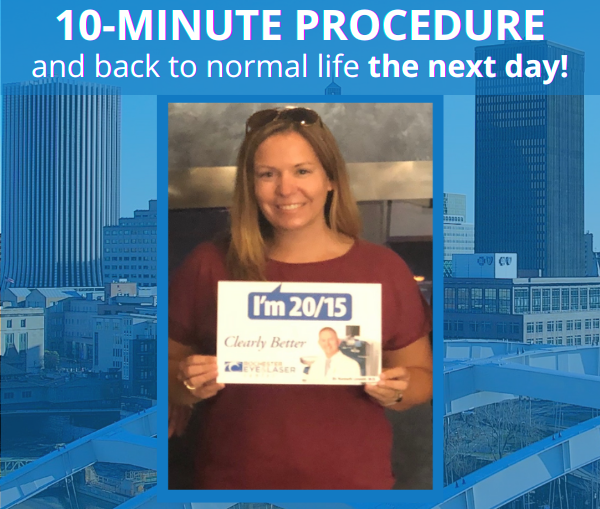LASIK is Super Easy & Quick
LASIK eye surgery may sound intimidating, not to mention costly, but the investment is the best thing you can do for yourself. It takes approximately...
5 min read
 The Rochester Eye & Laser Team
:
Mar 29, 2023 11:55:08 AM
The Rochester Eye & Laser Team
:
Mar 29, 2023 11:55:08 AM

LASIK, or Laser-Assisted in situ Keratomileusis, is a form of refractive surgery that can help correct vision problems like nearsightedness, farsightedness, and astigmatism. By reshaping the cornea using a laser to improve its focusing power, LASIK can reduce or eliminate your need for glasses or contacts. This procedure has become increasingly popular over the years due to its high success rate and minimal recovery time. But beyond just providing better vision, LASIK also offers an opportunity for those with vision problems to save money in the long run. With proper care and maintenance of your eyesight following the procedure, you could end up saving thousands on eyewear costs throughout your life.
When it comes to comparing traditional eyewear to LASIK costs, the difference is significant. Traditional glasses and contact lenses can cost hundreds of dollars per year for materials and regular checkups. In contrast, the average cost of a single LASIK procedure typically ranges from $2,500 to $5,000 depending on your vision correction needs and other factors such as laser type and geographic location. While this may seem like a large investment in the short term when considering its long-term benefits it can be more than worth it.
The main benefit of investing in LASIK is that you’ll no longer need to purchase corrective eyewear every few months or years. This means you’ll save money over time since you won’t have any additional expenses associated with contacts or glasses frames—which can add up quickly over time! Plus, if your eyesight changes again after having LASIK surgery (which happens rarely), there are refractive enhancements available that might still help correct your vision without needing to invest in expensive new glasses or contacts again.
In addition to saving money on eyewear purchases long-term, having LASIK also offers freedom from relying solely on prescription lenses at all times which some people find very liberating—especially those who participate in activities where traditional corrective eyewear isn't practical such as swimming or playing sports! Furthermore, many patients report feeling an improvement in their overall quality of life following the procedure due to being able to see clearly without worrying about how they look wearing glasses or dealing with uncomfortable contact lenses inside their eyes.
The decreased risk of eye injuries is one of the most important benefits to consider when deciding whether or not to have LASIK surgery. Without glasses or contact lenses, you no longer need to worry about them being knocked off your face in an accident and injuring your eyes. This is especially beneficial for those who engage in activities that are more likely to expose them to danger such as playing sports or working with tools and machinery.
Another major benefit of LASIK surgery is the potential savings it can offer on glasses or contacts over time. Since traditional corrective eyewear needs to be replaced every few months or years depending on how often you wear it, having LASIK allows you to eliminate this expense from your budget completely which could save you thousands in the long run! It’s important however, that even after having LASIK surgery, patients should still visit their optometrist regularly for checkups since any changes in their vision may require additional treatment down the road.
Finally, there are also emotional benefits associated with getting rid of corrective eyewear altogether thanks to LASIK surgery. People who only ever wore glasses before often feel a newfound sense of freedom once they don’t have to rely solely on prescription lenses anymore—which can make a huge difference in terms of self-confidence both professionally and socially!
When it comes to insurance coverage of LASIK, it is important to understand what your policy covers and how much you can expect to pay out-of-pocket. Unfortunately, many insurers do not provide coverage for this type of elective surgery as they consider it a cosmetic procedure. However, some plans may cover a portion of the cost if deemed medically necessary due to vision impairment from an existing condition such as nearsightedness or astigmatism. If you have any questions about whether your specific plan provides any form of reimbursement for LASIK procedures, contact your insurer directly for more information.
In addition to traditional health insurance, there are also alternative funding options available that can help ease the financial burden associated with LASIK surgeries. For example, some providers offer payment plans that allow patients to make low monthly payments instead of paying the full amount upfront—which could be especially helpful if you’re on a tight budget but still want the benefits that come with better eyesight! Additionally, certain medical credit cards like CareCredit may extend special financing offers which could help spread out costs over time as well.
Finally, many eye care practices also offer discounts and promotions throughout the year so keep an eye out for those when planning your procedure too! It never hurts to ask around and see if anyone in your network has had success taking advantage of these types of deals before committing to anything officially—you might be surprised at how much money you can save!
In order to maintain the benefits of LASIK, regular eye exams are essential. It is important to visit your eye doctor or optometrist at least once a year for an evaluation and check-up. This will allow them to monitor any changes in your vision that could indicate a need for further corrective surgery or other treatments. Additionally, they can provide advice on how best to take care of your eyesight following the procedure such as proper nutrition, wearing sunglasses when outside, and avoiding activities that may cause eye strain like staring at screens for too long.
It is also important to stay mindful of potential complications associated with LASIK surgeries so you can catch any issues early on if they arise. Common risks associated with this type of procedure include dryness, infection, and corneal haze—all of which can be managed with proper medical attention but should still be watched out for! If you experience itching, redness, or pain in either one or both eyes after having LASIK surgery it’s important to contact your doctor immediately so they can assess what might be causing it and recommend appropriate treatment measures accordingly.
Finally, taking proper care of your post-LASIK eyesight requires adopting healthy habits such as not rubbing or touching them excessively (which could lead to infection) and using lubricating drops if needed during times when discomfort arises due to environmental factors like windy weather conditions or low humidity levels indoors. Additionally, avoiding smoking cigarettes as well as swimming pools without protective goggles are recommended since these activities have been linked with an increased risk of developing certain types of infections that could damage the cornea over time!
While there is no question that LASIK surgery can be expensive and should not be taken lightly, the potential benefits it provides to those who choose to invest in it are undeniable. Not only does having LASIK eliminate the costs associated with traditional eyewear purchases and replacements over time, but it also offers a newfound sense of freedom from relying solely on corrective lenses at all times—especially for those who participate in activities where these aren’t practical! Furthermore, patients often report feeling an improved quality of life due to being able to see clearly without worrying about how they look wearing glasses or dealing with uncomfortable contact lenses inside their eyes. Finally, the decreased risk of eye injuries due to not needing traditional corrective eyewear anymore can provide further peace of mind for those engaging in more dangerous activities as well!
Fortunately, if you’re considering investing in this procedure there are several alternatives available that could help make affording it more manageable such as payment plans through providers or special financing offers from medical credit cards like CareCredit. Additionally, many eye care practices offer discounts throughout the year which could significantly reduce your out-of-pocket expenses too so keep an eye out for those when planning ahead! While making sure to get regular checkups afterward is important in order to maintain any improvements made by the surgery over time and watch out for any potential risks associated with postoperative care such as dryness or infection.

LASIK eye surgery may sound intimidating, not to mention costly, but the investment is the best thing you can do for yourself. It takes approximately...

Bifocals are eyeglasses that feature two lens powers, allowing wearers to see both near and far objects. In the past, individuals with bifocal vision...

Are you tired of the constraints of wearing glasses and contact lenses? You may have already thought about whether you would be a good LASIK...